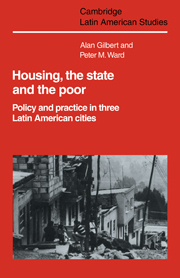Book contents
- Frontmatter
- Contents
- List of figures
- List of tables
- Acknowledgements
- Abbreviations
- 1 Introduction: the research issues and strategy
- 2 Bogotá, Mexico City and Valencia: the social, economic and political backcloth
- 3 Access to land
- 4 Servicing low-income settlements
- 5 Community organization: participation or social control?
- 6 Conclusions
- Appendix 1 The methodology in detail
- Appendix 2 Description of the survey settlements
- Notes
- Bibliography
- Author index
- Subject index
- CAMBRIDGE LATIN AMERICAN STUDIES
Appendix 2 - Description of the survey settlements
Published online by Cambridge University Press: 04 August 2010
- Frontmatter
- Contents
- List of figures
- List of tables
- Acknowledgements
- Abbreviations
- 1 Introduction: the research issues and strategy
- 2 Bogotá, Mexico City and Valencia: the social, economic and political backcloth
- 3 Access to land
- 4 Servicing low-income settlements
- 5 Community organization: participation or social control?
- 6 Conclusions
- Appendix 1 The methodology in detail
- Appendix 2 Description of the survey settlements
- Notes
- Bibliography
- Author index
- Subject index
- CAMBRIDGE LATIN AMERICAN STUDIES
Summary
The details of the settlements are summarized in table 1 on page 24 and the locations are depicted in figure 2 on page 26.
Bogotá – Atenas
Atenas is located on the mountain slopes along the road which leaves Bogotá for Villavicencio. Most of the settlement is on sloping terrain although there are several relatively flat sections. It is largely surrounded by low-income pirate urbanizations although there is still a limited amount of open land to the northwest. The settlement was developed in two parts beginning in the middle sixties, the first of which is now largely occupied and serviced, the second of which is less consolidated, lacks services and contains open ground.
The pirate urbanizer divided land which had been inherited by his father in the late twenties. He began to sell this land in the early sixties and provided certain services in an attempt to comply with the then ruling planning code: standpipes, road layout with paving stones and rough street surfacing. He later became a member of the Bogotá council and was identified with a campaign to service not only Atenas but several surrounding settlements. He used his contacts in the Liberal party to obtain services for these communities. He lost his position on the council in 1970 and indeed lost political influence generally. This has to some extent affected the recent servicing of the settlement.
- Type
- Chapter
- Information
- Housing, the State and the PoorPolicy and Practice in Three Latin American Cities, pp. 271 - 283Publisher: Cambridge University PressPrint publication year: 1985

